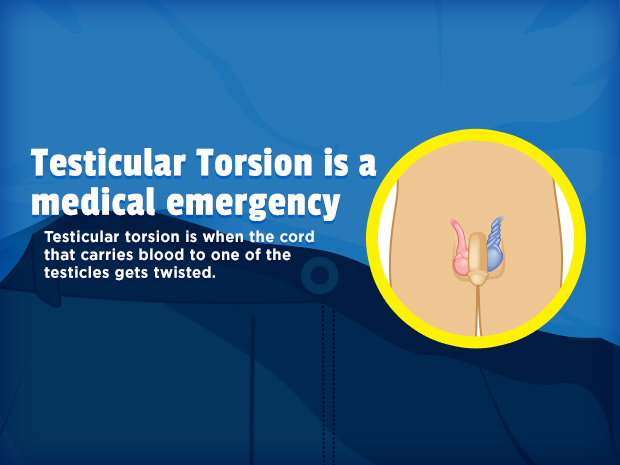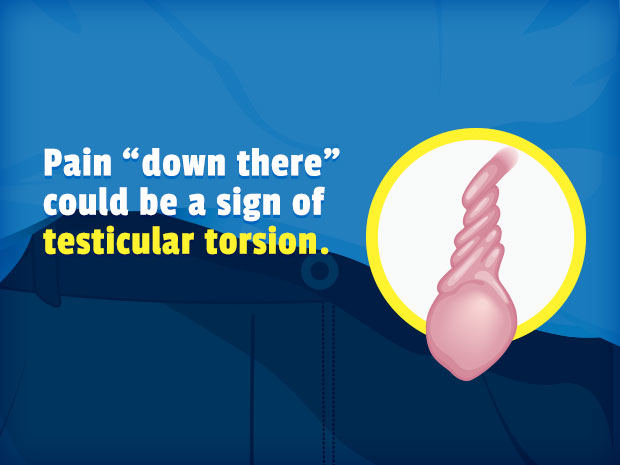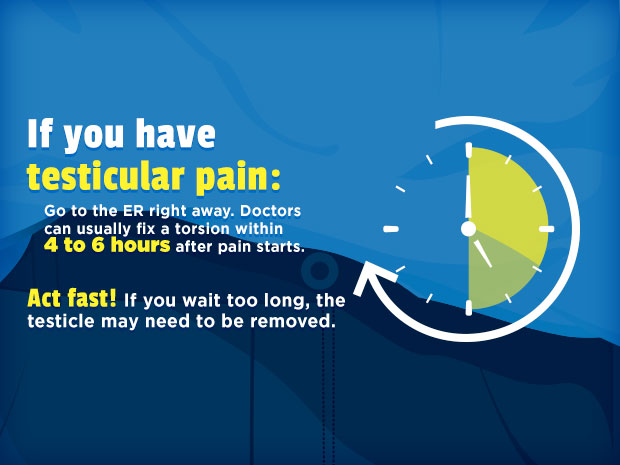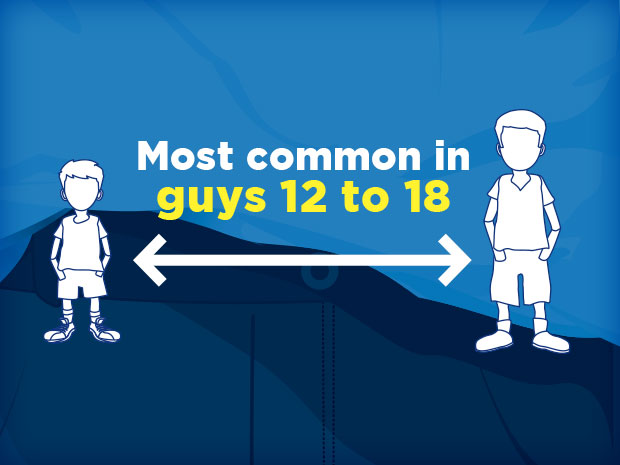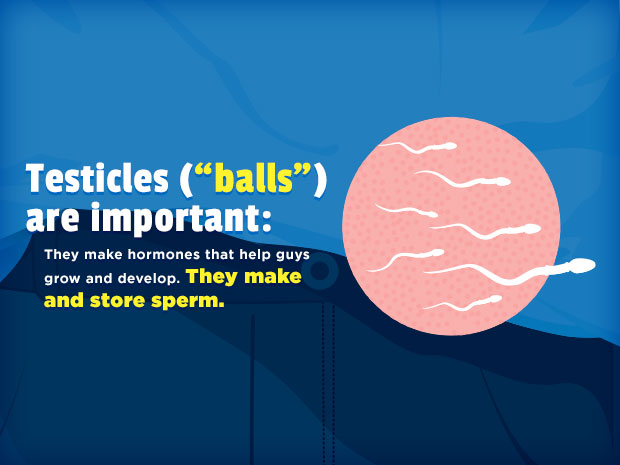What Is Testicular Torsion?
Testicular torsion is an emergency condition. It happens when the spermatic cord, which provides blood flow to the testicle, rotates and becomes twisted. The twisting cuts off the testicle's blood supply and causes sudden pain and swelling.
Testicular torsion requires surgery right away to save the testicle. Testicular torsion that goes on for more than a few hours can permanently damage the testicle, and a damaged testicle must be removed.
What Causes Testicular Torsion?
The scrotum is the sack of skin beneath the penis. Inside the scrotum are two testes, or testicles. Each testicle is connected to the rest of the body by a blood vessel called the spermatic cord. Testicular torsion happens when a spermatic cord becomes twisted, cutting off the flow of blood to the attached testicle.
Most cases of testicular torsion (also called testis torsion) affect guys who have a condition called a bell clapper deformity. In most males, the testicles are attached to the scrotum, making it hard for them to twist. In males who have the bell clapper deformity, the testicles are unsecured and can move and twist in the scrotum.
Testicular torsion can happen to boys and men of any age, but is most common in 12- to 18-year-olds. It can happen after strenuous exercise, while someone is sleeping, or after an injury to the scrotum. A lot of times, though, there is no apparent cause.
What Are the Signs & Symptoms of Testicular Torsion?
If you have a testicular torsion, chances are you'll know it. You'll feel a sudden, possibly severe pain in your scrotum and one of your testicles. The pain might increase and decrease but generally won't go away completely. Other symptoms include:
- swelling, especially on one side of the scrotum
- nausea and vomiting
- belly pain
- one testicle appears to be higher than the other
What Should I Do?
If you have a sudden pain in your scrotum, call a doctor and get to a hospital or doctor's office as soon as you can. Don't eat or drink anything until you've seen a doctor and found out if you'll need surgery. Testicular torsion is an emergency: When it happens, a guy needs surgery — fast. Saving the testicle becomes more difficult the longer the spermatic cord stays twisted.
As a general rule:
- within about 4–6 hours of the start of the torsion, the testicle can be saved 90% of the time
- after 12 hours, this drops to 50%
- after 24 hours, the testicle can be saved only 10% of the time
Sometimes, the spermatic cord can become twisted and then untwist itself without treatment. This is called torsion and detorsion, and it can make testicular torsion more likely to happen again. If your spermatic cord untwists and the pain goes away, it might be easy to ignore it, but you should call the doctor anyway. They can check you out and take steps to make another testicular torsion unlikely.
Get Help Right Away
Talking to someone about your private parts might seem a little embarrassing. It's really important, though, to tell a parent or contact a doctor if you have pain in your scrotum. Ignoring pain for too long or simply hoping it goes away can result in severe damage to your testicle and might lead to your testicle being removed.
Even if a pain in your scrotum goes away on its own, you still need to tell a parent or doctor. A torsion that goes away makes you more likely to have another one later. Doctors can greatly reduce your risk of another torsion by doing a simple surgical procedure that secures your testicles to your scrotum.
How Is Testicular Torsion Diagnosed?
When you arrive at the hospital or doctor's office and describe your condition, the staff and doctors will assume you have a testicular torsion, even if the pain turns out to be something different.
A doctor will examine your scrotum, testicles, abdomen, and groin and might test your reflexes by rubbing or pinching the inside of your thigh. This normally causes the testicle to contract, which probably won't happen if you have a testicular torsion.
The doctor also might do tests to see if the spermatic cord is twisted, including:
- Ultrasound. High-frequency (Doppler) waves are used to make an image of the testicle and check the blood flow.
- Urine tests or blood tests. These can find if the pain and symptoms are being caused by an infection instead of a torsion.
Sometimes, doctors will need to do surgery to be sure a problem is testicular torsion. A doctor may also do immediate surgery without any other testing in order to save the testicle. This is more likely if the torsion has been going on for a while or if the doctor suspects a guy has a torsion after examining him.
How Is Testicular Torsion Treated?
Testicular torsion almost always requires surgery to correct. In rare cases, the doctor might be able to untwist the spermatic cord by pushing on the scrotum, but most guys will still need surgery to attach both testicles to the scrotum to prevent torsion from happening again.
Usually, surgery for a testicular torsion doesn't require a stay in the hospital. If you have a torsion, you'll go into an operating room at the hospital or doctor's office. You'll most likely be given a painkiller and general anesthesia, meaning you'll be asleep and not feel pain during the surgery.
A surgeon or urologist will make a small cut in the scrotum, untwist the spermatic cord, and stitch the testicles to the inside of the scrotum to prevent future torsions. Then, the doctor will stitch up the scrotum, and you'll go to a room to recover for an hour or two.
The surgery to attach the testicles to the scrotum takes about 45 minutes. There may be some pain, but it shouldn't be too bad. It's much better than the torsion.
Sometimes, if the torsion goes on too long, doctors can't save the affected testicle. They'll need to remove it through a type of surgery called an orchiectomy (pronounced: or-kee-EK-teh-mee).
What Happens After Surgery?
Guys need to skip strenuous activities (like sports) and sex or sexual stimulation (like masturbation) for a few weeks after testicular torsion surgery. Talk to your doctor about when it will be safe to go back to your normal activities.
Even if your torsion led to the loss of a testicle, you can still lead a normal life, just like anyone else. Most guys will still be able to father children later in life and have normal sexual relations with one working testicle. Many also opt for a prosthetic, or artificial, testicle a few months after surgery. This can help make some feel more comfortable about their appearance.



